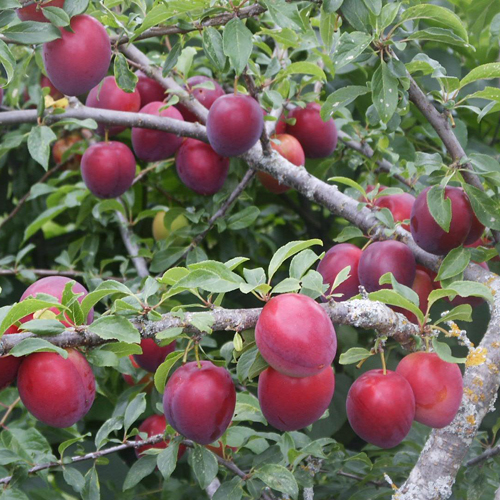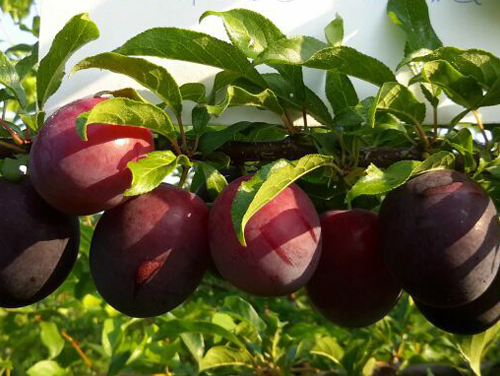Cherry plum variety Found
Choosing cherry plum for the garden, the gardener is trying to find a variety that would delight with the harvest and at the same time not cause trouble to care for. Among the large number of varieties, I would like to mention Naydenu. She was brought out at the Crimean experimental selection station of the All-Russian Research Institute of Plant Industry named after N.I. Vavilov. It is located in the Krasnodar Territory, in the city of Krymsk. The parental forms for the novelty are Chinese plum, Fast-fruited and Russian Dessertnaya. The authorship belongs to G.V. Eremin, S.N. Zabrodina, V.A. Matveev and M.P. Malyukevich. The date of registration of the application for the introduction of the variety into the State Register of Plants of the Russian Federation is 1986. Included in the register in 1993. The regions most suitable for cultivation are Nizhnevolzhsky (Volgograd, Saratov, Astrakhan regions and the Republic of Kalmykia) and Central Chernozem (Kursk, Lipetsk, Voronezh, Belgorod, Oryol, Tambov regions). Cherry plum is also popular in Belarus and Ukraine.

Description
The tree is medium-sized, decorated with a not too thickened flat-round crown. The stem is of normal thickness, even, covered with gray bark with large, but few lenticels. Shoots found are thick - 3.5 - 4 mm, grow horizontally, with little branching. The growing shoot has a green top; on the sunny side, a medium-intensity brown-red tan is formed. Small bouquet twigs, or overgrown, in the variety are short and short-lived - they live up to 3 years. Generative (flowering) buds are medium or small, round in shape, growing from the shoot. The scales of the expanding buds are colored pink at the edges.
A young leaf at first grows strictly vertically, but then takes a horizontal position. The cherry plum has a large leaf plate - 5.4 cm long, 3.2 cm wide, oval in shape with a pointed apex, wedge-shaped base, crenate and slightly wavy edge. The leaf surface is slightly shiny, light green, with slight pubescence and reticular veins. There are no glands at the base of the leaf blade. The petiole has standard dimensions - 1.3 - 1.4 cm, 12 mm thick, has a deep groove and is intensely stained with anthocyanin, no pubescence. The inflorescence of the variety consists of 2 small flowers, 1.6 - 1.7 cm in diameter. The corolla is slightly open. The petal is small, broadly ovate, 8 mm long and 7 mm wide. The edge of the apex is wavy, medium corrugated. Filaments are straight, small in length - 4 - 5 mm. There are 26 stamens in cherry plum. The pistil column is 9 mm high and has a slight bend. The stigma is rounded, located above the anther. Ovary without pubescence, naked. The calyx of the flower is naked, bell-shaped. Sepals pressed to the rim, oval, 3 mm long, 2 mm wide. The peduncle is of normal size.

Fruits are found medium to large, weighing 26 - 31 grams. Dimensions - length 30 mm and width 33 mm. The shape is oval or ovoid, asymmetric, the maximum diameter of the fruit is in the middle. The place of fusion of carpels in the ovary of the pistil, or the abdominal suture, is faintly or completely absent. The top of the cherry plum fruit is round, the funnel is narrow, of medium depth. The base is slightly elongated. The skin is not thick, dense, elastic, easily separated from the pulp. The main color is yellow, but it is invisible due to the integumentary, red-violet, which completely covers the area of the skin. Subcutaneous yellow dots cover the surface abundantly, there are much fewer strokes. The whitish waxy coating is of medium intensity. The pulp of the variety is of a beautiful orange color, fibrous in consistency, low juicy, medium-dense. The cavity is orange. In the air, the pulp is found practically not oxidized. Peduncle without pubescence, relatively short - 6 - 10 mm, separated from the fruit with effort. The content of nutrients in 100 grams of pulp: raw substances 12.30%, sugars 8.1%, acids 1.69%, pectin substances 0.35%, polyphenols 481 mg, flavonols 22.5 mg, anthocyanins 39.0%, ascorbic acid 6.4%, sugar acid index 4.8.
Cherry plum taste good, combining medium sugar content with slight acidity. The bone in Found is ordinary, has a weight of 0.53 grams, which is 2.39% of the total mass of the monoscrew. Length 1.7 cm, width 1.6 mm, thickness 1.1 cm. The shape is oval, from the side of the abdominal seam - elongated-elliptical, light brown color. The stone is symmetrical, has the greatest width in the middle. The keel is not developed. The surface is lumpy, the edges of the continuous seam are solid, do not merge. The width of the abdominal suture is standard, the apex is pointed, the base is wide, narrowly rounded. It separates from the pulp, but with effort.

Variety characteristics
- In the period of fruiting, the tree enters 2 - 3 years after planting;
- the early blooming dates of cherry plum, in April, may coincide with strong winds that will interfere with pollinating insects, so it is best to plant the plant in a secluded place;
- mid-July ripening period. Harvesting may take until the end of the month;
- Found pleases with a regular and high yield. An adult tree bears 35 to 50 kg of fruit;
- characterized by non-shedding of ripe fruits from the tree for almost two weeks and high resistance of fruits to cracking;
- the variety is highly adaptable, easily adapts to growing conditions;
- during the winter period, the tree perfectly resists the complex of environmental influences;
- drought resistance in the variety is average;
- cherry plum is well resistant to major diseases, especially resistant to clotterosporia;
- fruits of universal use - good fresh, suitable for conservation. The assessment of canned food is very high: compote - 4, 4 points, juice with pulp - 4.3 points, jam - 4.3 points, frozen fruits - 4 points.
Pollinators
Self-infertility forces another crop to be planted nearby. Good pollinators are the varieties Traveler, Nesmeyana, Vitba, Asaloda, Mara... If there is not enough space in the garden, then a pollinator branch can be grafted into the crown to Nayden.
Planting and leaving
For disembarkation, it is advisable to choose a sunny place, closed from the winds prevailing in winter. In lowlands, in order to avoid stagnant water in the roots, you can plant a tree on artificial hills. Subsoil waters should not flow closer than 1.2 - 1.5 meters to the surface.
Cherry plum does not need any special care. Timely watering and feeding is quite enough. Pruning is carried out in the spring, before the start of sap flow. The procedure is especially necessary during the period of active growth, which occurs in the first 10 years.
Gardeners highly appreciate Naydena, thanks to its unpretentiousness, early maturity, disease resistance, yield and fruit taste. The disadvantage is self-infertility. No other disadvantages have been identified.








